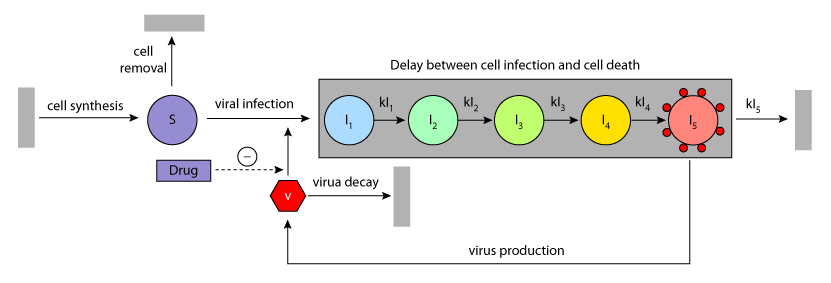Grossman, Feinberg, Kuznetsov, Dimitrov, Paul, 1998
Model Status
This is the original unchecked version of the model imported from the previous CellML model repository, 24-Jan-2006.
Model Structure
Highly active anti-retroviral therapy (HAART) significantly reduces the viral load in most HIV infected patients. Most believe that this is due to the drug's ability to act as an efficient blockade of the de novo infection of target cells. However, HAART is not 100 percent effective, usually because some long-lived infected cells persist, which then convert to short-lived HIV producers when activated. The extent to which virus production from infected to uninfected cells is blocked is of great importance. The answer will help to determine whether or not HAART is capable of eradicating HIV infection.
The concept that drug treatment is an efficient blockade of viral replication has derived much of its credibility from being incorporated into a model that successfully fits the kinetic data. This model of HIV dynamics was published by Perelson et al. in 1996. Their main observation was that viral load decline following drug application occurred in two discrete phases: an initial rapid decline (phase I) followed by a more gradual decline (phase II). They explained this observation by the fact that the drugs decreased viral load by inhibiting the de novo infection of susceptible cells. Phase I reflected the decline of the originally infected cells, and phase II reflected the decline of those infected cells which had a slightly longer half-life.
However, the authors of the current model, Grossman et al. argue that the idea of a cell having a half-life is biologically implausible. They suggest instead that it is more plausible to think of the infected lymphocytes undergoing an aging-like process. That is, the death of an infected, HIV-producing cell follows productive infection after a time delay (see the figure below). The observed exponential decline in viral load then requires an alternative explanation. This is provided by assuming that de novo infection is not blocked completely by HAART, but only reduced.
The complete original paper reference is cited below:
HIV infection: how effective is drug combination treatment?, Zvi Grossman, Mark Feinberg, Vladimir Kuznetsov, Dimiter Dimitrov, and William Paul, 1998, Immunology Today , 19, 528-532. (Full text (HTML) and PDF versions of the article are available on the Immunology Today website.) PubMed ID: 9818549
 |
| Schematic diagram of the conceptual model representing the cycles of infection of activated, susceptible cells (S), with delay-type kinetics of infected cell death. V represents the ambient virus, and Ij represents the infected cells in the various different stages of infection. |
Model simulations revealed that the half-life of the infected cells can be calculated with reasonable accuracy from clinical data. However, the remaining parameters can not be accurately predicted from the current model, more data is needed.
A variable delay from productive cell infection to cell death can be modelled by dividing the process into several sequential stages. These stages may represent real stages in the infection process, or they may be regarded as a modelling convenience. Another method of modelling a variable delay is to introduce a distribution of delay times around a fixed average. This is the approach chosen by the authors of the current model.

